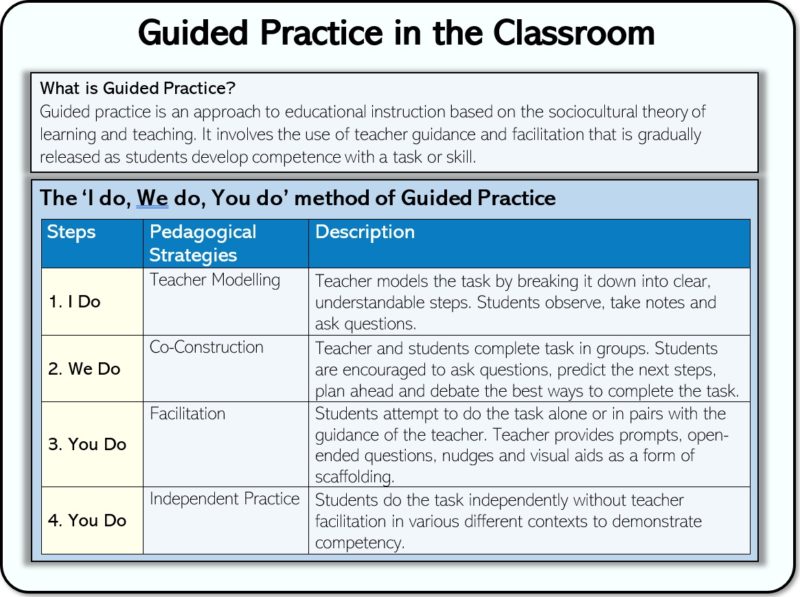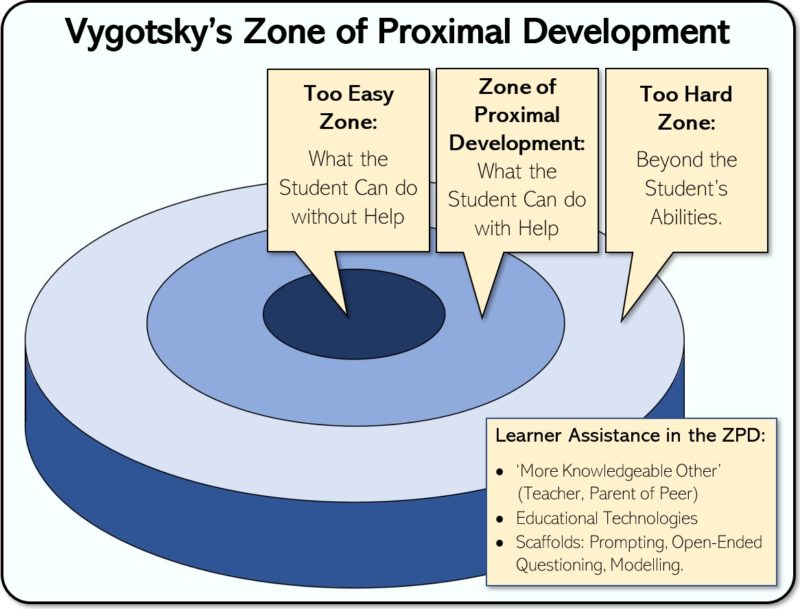

Written by Chris Drew (PhD)

Dr. Chris Drew is the founder of the Helpful Professor. He holds a PhD in education and has published over 20 articles in scholarly journals. He is the former editor of the Journal of Learning Development in Higher Education. [Image Descriptor: Photo of Chris]
| May 29, 2024
Guided practice is a teaching practice pioneered by Barbara Rogoff that helps scaffold student learning through modeling and gradual release of responsibility to the student.
It involves three steps for practicing new skills in the classroom:
This article outlines the most popular teaching strategy of guided practice for teaching: the I do, We do, You do method. You might also hear it called the “Gradual Release of Responsibility Model”.
Use this method to write lesson plans, help struggling students, and demonstrate your knowledge of good pedagogical skills during lesson reviews and observations.
Contents showHere are some ways scholars define guided practice. Use these sources to define it in your essay:
What we notice in these definitions is two key elements:
The I do, we do, you do method provides four clear steps for guided practice. It can be used as the basis for lesson plans or a guide when teachers have a student struggling to understand a concept.
The first step of the I do, we do, you do method is modelled instruction. Modelling gives learners the opportunity to understand the task and gather initial details about how it would be performed.
I recommend using some of the following strategies in the ‘I do’ modelling stage:
Learners are not necessarily passive in this stage. Learners should be reflecting and actively thinking while they watch the teacher modelling the information. Leave time for students to ask questions at the end of each step in your modelling.
While we often consider modelled instruction as to ‘direct’ and ‘transmissionist’ in its approach, the fact remains that sometimes students need to be given clear, direct instruction on information that is new to them.
The important thing is that we don’t just model instruction. We also need to give students the chance to practice, discuss and experiment with the new information. This is what happens in the following three steps.
At this stage, students participate in ‘shared practice’. Students work in groups or pairs to support each other through the learning process. Often, this will involve re-doing the modelling stage (Step 1) while the teacher and teachers’ assistants work to elicit students’ input as much as possible.
At this stage, teachers might want to consider:
While students work in groups at this stage, the teacher remains central to shaping the discussion. Some autonomy has now been released to the students to allow them to actively contribute their ideas while they have the support of their peers while completing the task.
The ‘you do’ stage of this gradual release of responsibility model is the first in which the individual student takes most of the control of the learning process.
In this stage, the student does their best to complete the task on their own. However, the teacher is present to patiently support students’ learning. Teachers and assistants can walk around the classroom giving guidance to any students who need it.
Some teachers prefer to ask students to do the facilitation stage in smaller groups, such as pairs.
Here are some examples of strategies for this stage:
It is important that the teacher observes students in this stage to identify misconceptions that students may have developed. If students skip this stage, they will not have an opportunity to be mentored through the early stages of independent learning.
Finally, students should reach a point of independent practice where they are freely able to complete the task on their own.
In this stage, strategies you can use include:
Ensure you provide students with the opportunity to seek facilitation if need be. While you have removed active facilitation, leave the door open for further guidance if the students solicit it.
By the end of Step 4, the teacher will need to re-assess the student’s zone of proximal development. They will have pushed the boundaries of their zone of proximal development out further, and tasks that were previously beyond reach may now be possible with guidance.
Assess the student’s new zone of proximal development and re-start the process at Step 1. The I do, We do, You do process should be considered cyclical.

Image 1: Guided Practice in the Classroom
Guided practice has its origins in the sociocultural theory of teaching and learning (also known as the social-constructivist theory). This theory emphasises the importance of social interaction for cognitive development.
Guided practice builds on three key theoretical concepts within the sociocultural theory: Vygotsky’s Zone of Proximal Development, Vygotsky’s More Knowledgeable Other and Bruner’s Scaffolding.
Vygotsky hypothesised that the best way to teach learners is to create lessons that are just too hard for students to complete on their own, but possible for students to do with the aid of a teacher.
We often call this the Goldilocks Principle: A lesson that’s too easy won’t lead to much learning. A lesson that’s far too hard will simply confuse students. But, a lesson that is challenging but not impossible should motivate students and lead to maximum learning development.

Image 2: Vygotsky’s Zone of Proximal Development
For students to achieve maximum progression in their learning, Vygotsky proposed that students should learn alongside a ‘More Knowledgeable Other’. A More Knowledgeable Other can be a teacher, parent or classmate. The MKO should simply be someone who can provide assistance like prompting, modelling, explaining and suggesting that keeps the learner on the path towards achieving their educational goals.
Importantly, because there is a guide, scholars argue that students will be learning in culturally and socially relevant ways. In other words, they learn things the ways their teachers, society and culture have deemed appropriate.
Guided practice is therefore also considered a culturally sensitive pedagogy.
Bruner expanded on Vygotsky’s ideas by introducing the concept of ‘scaffolding’. Instructional scaffolding is a term that emphasises the importance of guidance during the learning process to help a student move through their Zone of Proximal Development.
A scaffold is any learning strategy that keeps a student on the path towards their learning goals. As the student gets more competent at their tasks, the scaffolding should be removed so that the student can eventually complete the task alone.

Image 3: Bruner’s Instructional Scaffolding
Duchesne, S., McMaugh, A., Bochner, S., & Krause, K. L. (2013). Educational psychology: For learning and teaching (4th ed.). South Melbourne, VIC: Cengage Learning.
Sharratt, L. (2013). Scaffolded Literacy Assessment and a Model for Teachers’ Professional Development. In Elliott-Johns, S. & Jarvis, D. (Eds.) Perspectives on Transitions in Schooling and Instructional Practice. (pp. 138-155) Toronto: University of Toronto Press.
Guided Practice: Duchesne et al. (2013, p. 90) define guided practice as “support provided to enable students to participate in expert activities in increasingly expert ways.”
Definition: Guided practice is a teaching practice pioneered by Barbara Rogoff. It involves three steps for practicing new skills in the classroom. First, the teacher models how to do a task to the student. Second, the student does the task with guidance from the teacher. Third, the student practices the task independently.
Examples: The I Do, We Do, You Do method is an example of guided practice. This is a three-step model:
What is Guided Practice?
Guided practice is an approach to educational instruction based on the sociocultural theory of learning and teaching. It involves the use of teacher guidance and facilitation that is gradually released as students develop competence with a task of skill.
The I do, We do, you do method of Guided Practice:
| Steps | Pedagogical Strategies | Description |
|---|---|---|
| 1. I Do | Teacher Modelling | Teacher models the task by breaking it down into clear, understandable steps. Students observe, take notes, and ask questions. |
| 2. We Do | Co-Construction | Teacher and students complete task in groups. Students are encouraged to ask questions, predict the next steps, plan ahead and debate the best way to complete the task. |
| 3. You Do | Facilitation | Students attempt to do the task alone or in pairs with the guidance of the teacher. Teacher provides prompts, open-ended questions, nudges and visual aids as a form of scaffolding. |
| 4. You Do | Independent Practice | Students do the task independently without teacher facilitation in various different contexts to demonstrate competency. |
Vygotsky’s zone of proximal development has three zones that can be shown as concentric circles like ripples in a pool. From the inside out, they aer:
Learner assistance within the ZPD can include:
What is Scaffolding?
An insturctional scaffold is a temporary learner support provided to help a student learn how to compelte a task. The scaffold should be withdrawn once the student is capable of completing the task alone.
Examples of scaffolding